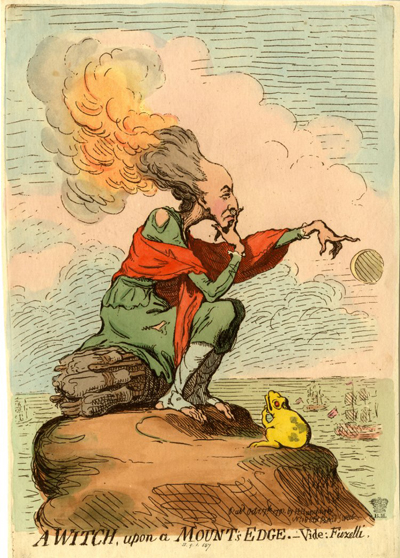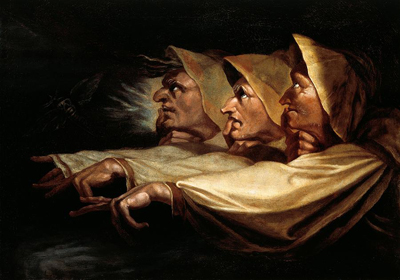A Witch upon a Mount's Edge
Like many portrait caricatures, the title of this print does not explicitly name but rather plays upon the subject's identity: in this case, Emma, Countess of Mount Edgcumbe, the daughter of John Gilbert, Archbishop of York and a friend of Horace Walpole.
She had always been accounted plain or even ugly. When sitting for a portrait by Sir Joshua Reynolds, she is supposed to have said, "I do not know what you may think of my face for a picture, but this I know, that it is no common face." Reynolds is said to have replied, "Thank God it is not."

© Trustees of the British Museum
Gillray had already portrayed the unfortunate Lady Mount Edgcumbe in 1780 in one of his first portrait caricatures. And in 1787, he included her again among the aging devotees of Love in La Belle Assemblee.
This particular print is supposed to have originated in a remark by Mrs. Albinia Hobart who as part of some forgotten argument called the Countess "a witch." Borrowing the boney finger to her lip and the outstretched arm and hand from Henry Fuseli's painting of the three witches in Shakespeare's Macbeth, Gillray portrays the Countess as another witch, complete with flaming hair, a bundle of broomsticks, and a frog as her familiar. She gazes out towards an ominous looking crescent moon over what is probably Plymouth bay visible from Mount Edgcumbe.

The Three Witches [1783]
© The Kunsthaus Zurich
Gillray was to use the Fuseli painting and his own treament of the partial moon in A Witch upon a Mount's Edge two months later in Wierd-Sisters; Ministers of Darkness.
Sources and Reading
- Commentary from the British Museum on A Witch upon a Mount's Edge
- Draper Hill, Mr. Gillray The Caricaturist, 1965, p. 148n
- Thomas Wright and R.H. Evans, Historical and Descriptive Account of the Caricatures of James Gillray #388
Comments & Corrections
NOTE: Comments and/or corrections are always appreciated. To make that easier, I have included a form below that you can use. I promise never to share any of the info provided without your express permission.